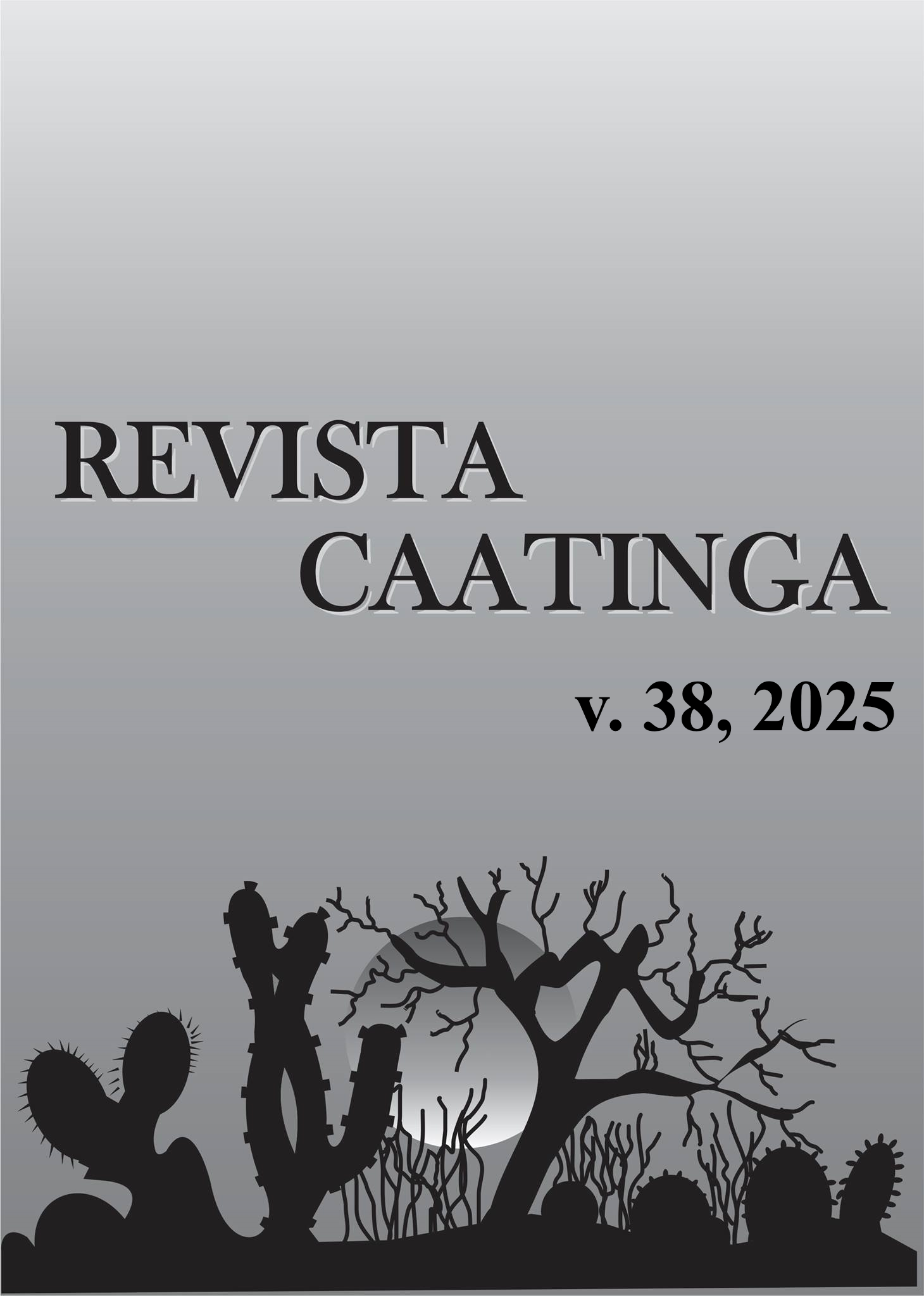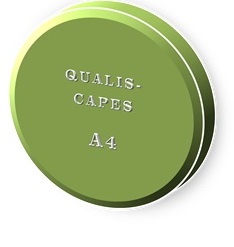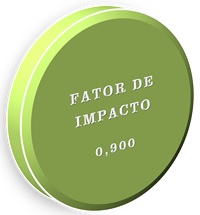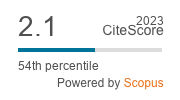Anthracnose severity in F2 lima bean progenies obtained by hybridization without emasculation
DOI:
https://doi.org/10.1590/1983-21252025v3812707rcKeywords:
Phytopathological assessment. Colletotrichum truncatum. Artificial hybridizations. Phaseolus lunatus. Progeny selection.Abstract
The objective of this study was to obtain anthracnose-resistant lima bean progeny by artificial hybridization. The study was conducted at the Agricultural Sciences Center of the Federal University of Piauí (UFPI), Teresina – Piauí. For the F2 phytopathological evaluation experiment, a completely randomized experimental design was used with four replicates per progeny and a plot consisting of one plant. For inoculation, the CT4 isolate of Colletotrichum truncatum was used at 106 spores/mL, and a control plant was inoculated with autoclaved distilled water. Ten trifoliate leaves of each genotype were scanned from the intermediate region of the plant using ASSES 2.0. After assessing the severity, the average ratings for each population were calculated, classifying them into five categories according to the resistance. To conduct the analysis of variance, the severity data were transformed by and grouped by the test proposed by Scott and Knott (P < 0.05). All analyses were performed using the R and GENES programs. Seven days after inoculation, the progênies were divided into three groups. Groups “A” and “B” corresponded to genotypes classified as highly susceptible and group “C” to genotypes classified as moderately resistant and highly resistant. The genotypes BGP-UFPI 220, BGP-UFPI 251, BGP-UFPI 798, BGP-UFPI 832, BGP-UFPI 1000, and BGP-UFPI 1002 can be used as parents in lima bean improvement programs. Progenies that were moderately resistant and highly resistant, totaling sixteen, were selected for use in breeding programs aimed at anthracnose resistance.
Downloads
References
ADEBO, J. A. A Review on the Potential Food Application of Lima Beans (Phaseolus lunatus L.), an Underutilized Crop. Applied Sciences, 13: 1996, 2023.
ASSUNÇÃO, I. P. et al. Reaction of faba bean genotypes to Rhizoctonia solani and resistance stability. Horticultura Brasileira, 29: 492-497, 2011.
ASSUNÇÃO-FILHO, J. R. et al. Selection of superior genotypes of lima bean landraces by multivariate approach. Revista Caatinga, 35: 87-95, 2022.
BELMINO, C. S. Resistência do feijão-caupi a Colletotrichum truncatum. 2004. 64 f. Tese (Doutorado em Fitopatologia) – Universidade Federal de Viçosa, Viçosa, 2004.
BLISS, F. A. Common bean. In: FEHR, W. R.; HADLEY, H. H. (Eds.). Hybridization Of Crop Plants. New York: Wiley, 1980. cap. 17, p. 273-284.
BONITA, L. C.; SHANTIBALA DEVI, G. A.; SINGH, B. C. H. Lima Bean (Phaseolus lunatus L.) - A Health Perspective. International Journal of Scientific & Technology Research, 9: 5638-5649, 2020.
BRITO, M. V. Caracterização morfoagronômica e seleção de genótipos de feijão-fava resistentes ao Colletotrichum truncatum. 2017. 65 f. Dissertação (Mestrado em Genética e Melhoramento: Área de Concentração em Genética e Melhoramento) – Universidade Federal do Piauí, Teresina, 2017.
BRITO, M. V. et al. Associação entre resistência de Phaseolus lunatus a Colletotrichum truncatum e caracteres morfoagronômicos. Summa Phytopathologica, 48: 69-77, 2022.
CARMO, M. D. S. et al. Avaliação de acessos de feijão-fava, para resistência a Colletotrichum truncatum, em condições de folhas destacadas e campo. Summa Phytopathologica, 41: 292-297, 2015.
CARVALHO, E. M. S. Antracnose em feijão-fava (Phaseolus lunatus L.): Caracterização do agente causal e reação de genótipos a Colletotrichum truncatum. 2009. 53 f. Tese (Doutorado em Agronomia. Área de concentração em Produção Vegetal) – Universidade Estadual Paulista, Jaboticabal, 2009.
CAVALCANTE, G. R. S. et al. Reação de subamostras de feijão-fava à antracnose. Summa Phytopathologica, 38: 329-333, 2012.
CAVALCANTE, G. R. et al. Diversity, prevalence, and virulence of Colletotrichum species associated with Lima bean in Brazil. Plant Disease, 103: 1961-1966, 2019.
CRUZ, C. D. GENES - a software package for analysis in experimental statistics and quantitative genetics. Acta Scientiarum, 35: 271-276, 2014.
GARCIA, T. et al. Comprehensive genomic resources related to domestication and crop improvement traits in Lima bean. Nature Communications, 12: 1-17, 2021.
GOMES, R. S. S. et al. Reactions of lima bean (Phaseolus lunatus L.) accessions to Colletotrichum truncatum. Revista Caatinga, 35: 809-817, 2022.
GRANJA, M. B. et al. Variedades de feijão-fava submetidas à níveis de salinidade e adubação orgânica. Colloquium Agrariae, 15: 104-114, 2019.
IBGE - Instituto Brasileiro de Geografia e Estatística. Banco de dados agregados: pesquisa: produção agrícola municipal, 2021. Available at: https://www.ibge.gov.br/explica/producao-agropecuaria/fava/br. Access on: Jan. 20, 2022.
IPGRI - International Plant Genetic Resources Institute. Descritores para Phaseolus lunatus (Feijão-espadinho). Roma: International Plant Genetic Resources Institute, 2001. 51 p.
LAMARI, L. ASSESS 2.0: Image Analysis Software for Plant Disease Quantification. St. Paul: American Phytopathological Society, 2008. 125 p.
NASCIMENTO, A. D. et al. Severidade da antracnose do feijão fava afetada por doses de cálcio e fontes de silício. Revista Ciência Agrícola, 15: 61-68, 2017.
R CORE TEAM. R: a language and environment for statistical computing. Vienna: R Foundation for Statistical Computing, 2023.
SANTOS, A. R. B. et al. Seleção de subamostras de feijão-fava para resistência à antracnose. Revista Brasileira de Engenharia de Biossistemas, 9: 268-278, 2015.
SCOTT, A. J.; KNOTT, M. A cluster analysis method for grouping means in the analysis of variance. Biometrics, 30: 507-512, 1974.
SILVA, J. M.; CHAVES FILHO, J. T.; MELO FERREIRA, A. Concentração de Carboidratos Solúveis em Folhas de Phaseolus lunatus L. em Relação ao Sombreamento. Revista EVS-Revista de Ciências Ambientais e Saúde, 37: 403-417, 2010.
SOUSA, A. et al. Artificial hybridization without emasculation in lima bean (Phaseolus lunatus L.). Revista Caatinga, 35: 223-230, 2022.
Downloads
Published
Issue
Section
License
Os Autores que publicam na Revista Caatinga concordam com os seguintes termos:
a) Os Autores mantêm os direitos autorais e concedem à revista o direito de primeira publicação, com o trabalho simultaneamente licenciado sob a Licença Creative Commons do tipo atribuição CC-BY, para todo o conteúdo do periódico, exceto onde estiver identificado, que permite o compartilhamento do trabalho com reconhecimento da autoria e publicação inicial nesta revista, sem fins comerciais.
b) Os Autores têm autorização para distribuição não-exclusiva da versão do trabalho publicada nesta revista (ex.: publicar em repositório institucional ou como capítulo de livro), com reconhecimento de autoria e publicação inicial nesta revista.
c) Os Autores têm permissão e são estimulados a publicar e distribuir seu trabalho online (ex.: em repositórios institucionais ou na sua página pessoal) a qualquer ponto antes ou durante o processo editorial, já que isso pode gerar alterações produtivas, bem como aumentar o impacto e a citação do trabalho publicado (Veja O Efeito do Acesso Livre).







